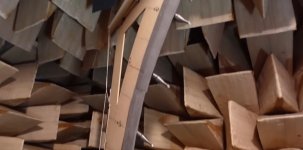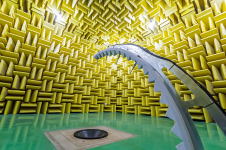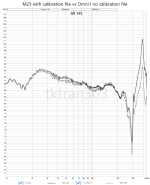The equivalent 'swept filter' for each Harmonic is so narrow band that very little noise is picked up.
Not narrow enough.
If there is not a distortion peak in that "narrow band" but only noise, that band of noise is sliced out and used for the distortion calculation.
If the system using Farina's method can operate synchronously and do coherent averaging, or can operate with very long sweeps and windowing, or operate with dual fft and do averaging, then noise can be traded off for measurement time. If doubling the number of averages or time stops reducing the measured distortion, then noise removal is sufficient.What measuring method can tell the difference?
Last edited:
If there is not a distortion peak in that "narrow band" but only noise, that band of noise is sliced out and used for the distortion calculation.
Bill, I think DualTriode is referring to 'noise' that is actually a 'distortion'; his 'iron noise' caused by the stimulus. Like Quantisation Distortion / Noise in badly dithered Digital systems but at much higher level.If the system using Farina's method can operate synchronously and do coherent averaging, or can operate with very long sweeps and windowing, or operate with dual fft and do averaging, then noise can be traded off for measurement time. If doubling the number of averages or time stops reducing the measured distortion, then noise removal is sufficient.
In that case, Angelo's method picks up exactly what it should do; the amount of 'noise/distortion' within its swept filter bandwidth. Need to specify the sweep length / filter bandwidth etc so you can explain what your display shows on 'noise' instead of a 'sine'. But you need to do that for ALL stuff measuring 'noise' and a 'sine' simultaneously.
But you are right about Angelo's method. In theory and practice it needs the least amount of time/averaging bla bla to achieve a given accuracy in the presence of environmental noise.
For the confused, another example:
The stuff that will show up on a rub and buzz sweep will as show up as distortion on a distortion sweep. Place a ring of keys on top of a speaker enclosure and run sweeps with the keys on the enclosure and without the keys. The vibrating keys will show up on the distortion sweep as distortion.
The stuff that will show up on a rub and buzz sweep will as show up as distortion on a distortion sweep. Place a ring of keys on top of a speaker enclosure and run sweeps with the keys on the enclosure and without the keys. The vibrating keys will show up on the distortion sweep as distortion.
Post your cal file.
The cal in my graph came from a user on audioscience. It does only adjust less than .5db?
I also own a 23R - there is no cal file. You sure you have the 23 or the 23R?
So, before insisting that my M23R does not have a calibration file I double-checked. Note, for the M23 and some others you have to go to the Earthworks site and enter the Serial Number to get the calibration file. The reason for paying the extra $100 for the M23R is because it does not need a calibration file. HOWEVER, I was able to enter my Serial Number and Earthworks sent me a calibration file. It is pretty much a flat line.
What matters for most loudspeaker measurement is the calibration file. All the cheap mics, including Dayton, are fine for relative SPL measurement for crossover work IF they have a reliable calibration file. The problem is how do you get a reliable calibration file. Many years ago, the Dayton's had an issue with having poor calibration files, I have no idea if this was resolved. Buy you could get them calibrated by Cross Spectrum Labs. Cross Spectrum's webpage has been so poorly maintained for the last 2 years that I can't even figure out what they do and don't do anymore.
Note, the mic came with a paper with the graph below, and this was emailed to me when I submitted the request for a calibration file. They also emailed a comma-delimited file with this data in it, but as I said, it is basically a nearly straight line at 1.78db.
CSL:
"Shipping update (Apr 26, 2024): We apologize for the lack of updates. (UMIK-2) mics are currently unavailable. A combination of health issues, equipment issues and project schedules have consumed the bulk of our energy as of late and we haven't had time to focus on microphones. We will continue to sell calibrated microphones and meters. We just need a little patience from everyone. Thanks for your understanding, and we'll provide further updates as we have them."
My 2024 built M23 is very flat:

That's +/- 0.3dB from 760Hz to 23KHz
Re: the M23R vs M23. Perhaps it a binning process, because the marketing suggests that any M23R can be replaced with another M23R (ie. close in sensitivity, not just flatness)
"Shipping update (Apr 26, 2024): We apologize for the lack of updates. (UMIK-2) mics are currently unavailable. A combination of health issues, equipment issues and project schedules have consumed the bulk of our energy as of late and we haven't had time to focus on microphones. We will continue to sell calibrated microphones and meters. We just need a little patience from everyone. Thanks for your understanding, and we'll provide further updates as we have them."
My 2024 built M23 is very flat:
That's +/- 0.3dB from 760Hz to 23KHz
Re: the M23R vs M23. Perhaps it a binning process, because the marketing suggests that any M23R can be replaced with another M23R (ie. close in sensitivity, not just flatness)
Last edited:
I imagine removing the requirement for cal files is quite attractive to sound techs always on the move, perhaps using different terminals and not just the same laptop for all their stops. Some stages/locations may have little/no internet access.
Member
Joined 2003
For a calibration free linear mic, probably already mentioned that Line Audio Omni1 is a good option and fairly inexpensive. I believe @tktran303 completed a direct comparison to an Earthworks reference.
Btw if you are wondering how such a small capsule as Earthworks uses performs at 90° and if it has a significant influence to your measurements ... it has.

Used for e.g. for surround calibration with DIRAC - you point your mic upwards cause you can't point to every speaker for every measurement.
When you don't take care about this your results sound harsh.
Response is wonky cause measured in 1m instead of 50cm I do normally in my room, so you see room influences already. And reflections from the mic clamp and stand from different positioning.
Used for e.g. for surround calibration with DIRAC - you point your mic upwards cause you can't point to every speaker for every measurement.
When you don't take care about this your results sound harsh.
Response is wonky cause measured in 1m instead of 50cm I do normally in my room, so you see room influences already. And reflections from the mic clamp and stand from different positioning.
Mine is straight from 30Hz to 3k. Above 3k up to 13k +1dB. It peaks at 17k with +3dB. While perfectly useable it’s not ruler straight 20-20k.Line Audio Omni1 is a good option
Member
Joined 2003
I’m not quite following what you mean here.Neither the hardware ( microphone or amplifier and other stuff ) nor the software know or care about there being a difference between Harmonics or Noise.
Harmonics and noise are actually pretty distinct in terms of their characteristics.
With harmonics, there’s phase correlation.
With noise, there’s no such correlation.
That’s a fundamental difference between these types of signals.
Interesting, because they claim to be flat up to 20kHz on their website.Mine is straight from 30Hz to 3k. Above 3k up to 13k +1dB. It peaks at 17k with +3dB. While perfectly useable it’s not ruler straight 20-20k.
So is that a false claim?
Line Audio Omni1 is a good option
Mine is straight from 30Hz to 3k. Above 3k up to 13k +1dB. It peaks at 17k with +3dB. While perfectly useable it’s not ruler straight 20-20k.
Yes.Interesting, because they claim to be flat up to 20kHz on their website ... So is that a false claim?
What Mark describes is exactly what I'd expect from an inexpensive 'measurement' mike from electret capsules.
It is possible Earthworks now have a little EQ network in their measurement mikes cos the capsules they now use to replace their original, Unobtainium Panasonic capsules are less consistent. The EQ would have to be twiddled individually.
From designing & making 'measurement' mikes circa 1980, I should really point out several caveats about 'calibration' curves. Please excuse dis lazy beach bum for not doing so. Even the Earthworks curve in #330 has a dubious feature which probably isn't there. It's the 0.3dB droop at about 1.5 kHz.
I’m not quite following what you mean here.
Harmonics and noise are actually pretty distinct in terms of their characteristics.
With harmonics, there’s phase correlation.
With noise, there’s no such correlation.
That’s a fundamental difference between these types of signals.
Waltzing around the difference between correlation and causation in 3/4 time, is "port noise" noise or distortion?
That is obviously not the right definition of correlation in this context.between correlation and causation
If something is broadband = noise
If a single or just a few frequencies = distortion
See you data acquisition book, these things are well and universally defined.
Also they can explain things much better and more thorough, I am not a teacher + a forum is far to constraint to explain all the ins and outs.
Get a copy, open and read to refresh the mind once in a while 🙂
- Home
- Loudspeakers
- Multi-Way
- Measurement mics


